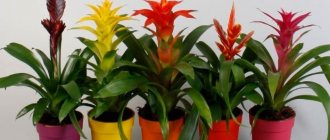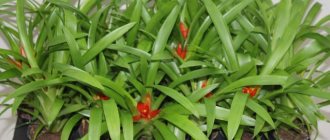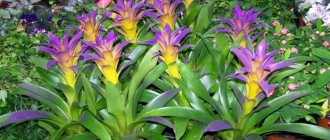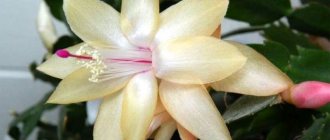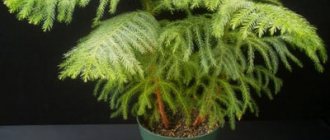The bromeliad family is amazing in all its manifestations. It is impossible to ignore guzman, widespread in the tropical forests of America. At first glance, it seems that fantastic plants have sprouted on trees, hanging vines, and dried snags.
However, the first impression is wrong: guzmania only clings to its roots with its roots, but nutrition occurs through the leaves. More precisely, through a funnel of leaves in the center of the plant: moisture and pieces of dead plants, dust and organic matter fallen from trees during rains accumulate there. This is what the tropical beauty feeds on. Amazing, isn't it? Such plants are called reservoir epiphytes.
Description of Guzmania
The plant has wide, long leaves collected in a rosette. During the flowering period, bracts of bright colors grow - scarlet, burgundy, coral, burgundy, crimson shades. Nature thus got out of the situation by attracting the attention of insects to small, inexpressive white flowers. After flowering, seed pods with many small seeds are formed, which can be used for sowing and obtaining new plants. The roots of Guzmania are underdeveloped and almost do not participate in the nutrition of the flower.
The second interesting fact is that after flowering, guzmania dies, releasing several shoots, or children, before dying. It is the young specimens remaining after the mother bush that are the predominant method of propagation of Guzmania.
Table: necessary conditions for the growth and development of indoor epiphyte
| Season | Lighting | Humidity | Temperature | Watering | Fertilizer |
| Winter | The location of the flower does not play a special role. The main thing is to protect it from direct sunlight, which can leave burns on the leaves. | Keep away from batteries, spray daily with water at room temperature. | 18–20 °C | Two times a week | No need |
| Spring | Daily spraying | 19–21 °C | Three times a week | Once a month | |
| Summer | Shade between 11 a.m. and 4 p.m. in sunny weather. | Spray only in hot weather, at temperatures above 25 °C. | 21–25 °C | Every day in the socket | Twice a month |
| Autumn | Daily spraying after turning on the heating appliances. | 20–22 °C | Two to three times a week | No need |
Guzmania transplant after purchase
How to transplant Guzmania photo
It is better to immediately transplant the purchased plant into a beautiful, spacious pot with prepared nutritious soil; read more about the composition of the soil below. Transplantation is carried out using the transshipment method: water the soil and leave for several hours until it becomes limp. Afterwards, carefully release the earthen lump from the pot, trying not to disturb its integrity.
Lay out a drainage layer of expanded clay, cover the soil with a layer of several centimeters, install the guzmania vertically, and fill the side space with soil. Water carefully. If the ground has subsided, it is filled up to the original level.
Reproduction
After flowering, the plant itself takes care of reproduction and produces several children. To breed new flowers, it is enough to separate them from the mother one and plant them separately. This process is quite easy, the only difficulty is separating the roots of the baby. Being very fragile, they easily break or remain on an adult specimen.
Reproduction methods
There are only 2 of them:
- Vegetative - lateral shoots
- Seminal.
Children can be separated only when the root system has developed enough to grow independently. Usually, tall shoots that have reached the height of the mother are separated. In any case, the size of the baby should be at least 13-14 cm.
The shoots are cut off with a sharp thin knife and the roots are very carefully separated, trying not to tear them off from the baby. It is recommended to treat the wound with crushed charcoal - charcoal or activated. Reproduction by children is the most affordable and easiest way.
You can try to grow guzmania from seeds. They are taken from a plant that has flowered and formed a seed pod. The material is immediately sown in the ground before it loses its viability. For this, a light substrate of sand and peat is used, placed in a box.
Seeds can germinate only in light, so they are not buried in the soil, but placed on the surface. The box is covered with glass and constantly ventilated to prevent soil acidification. Sprouts appear within 2.5-4 weeks.
How to care for guzmania at home
Indoor Guzmania flower photo Guzmania at home
Tropical plants are quite comfortable in an apartment; it remains to add a little care so that the green beauties feel no worse than in the wild. To do this, arm yourself with knowledge of simple agricultural technology.
Air temperature and lighting
Considering the light shade of the second tier of the tropical jungle, create similar lighting for your pet. The east and west windows of the apartment will be a great place for guzmania. Northern windows will be uncomfortable due to the low intensity of daylight, while southern windows, on the contrary, will lead to burns or even death of the plant.
The temperature regime is also close to the usual conditions of our summer and winter: in the hot period it is preferably warm 24-25 ° C, in the cold - about 20 ° C.
Fresh air is simply necessary for guzmania, but it must be ventilated carefully, avoiding drafts, otherwise the beauty may get sick or refuse to bloom.
How to water Guzmania
Guzmania watering and fertilizing at home
Anyone can enjoy the watering process: the fascinating action is especially interesting for children. It's no joke, the flower is watered not at the root, but in the center of the leaf rosette!
- Water should be there constantly in hot weather, and in winter it is left for several hours and drained to prevent the development of rot.
- In summer, water daily; in winter, reduce watering to twice a week.
- The soil in the pot should also be slightly moist; do not forget to spray it regularly with a spray bottle.
- By the way, spraying water on the leaves also has a very beneficial effect on the condition of the plant. It’s good to give the beauty a shower in the bathroom at least once a week, washing off the dust from the leaves. Refreshing procedures can transform guzmania, stimulating active growth and flowering.
- When you notice a peduncle emerging, be careful with watering: water should not get on it, and it is better not to leave water in the funnel, watering the plant through a tray into which small stones or pebbles are placed.
An excellent way to maintain high air humidity around the flower (about 85%) is to plant moss on the surface of the ground in a pot. Moss evaporates moisture perfectly, creating a favorable microclimate.
How to feed Guzmania
In spring and summer, during the period of active growth, guzmania is regularly fed with fertilizers for orchids. To do this, prepare a solution according to the instructions and pour it into the outlet through which the plant is fed. The frequency of feeding is once every two to three weeks.
Additional nutrition promotes the active development of leaves and stimulates flowering and the growth of more side shoots.
Guzmania during flowering
Guzmania bloomed: how to care for photo
We have to wait two to three years for this miracle. However, the gardener’s patience is fully rewarded: guzmania blooms for several months, delighting with the splendor of its colors. The enchanting action ends with the death of the flower, which leaves behind young shoots - babies that should be used to produce new plants.
Care during flowering comes down to careful watering through a tray, without stagnating water in the ground. It would also be a good idea to feed, but at the root, so that water that gets into the outlet does not provoke the development of rot.
However, many gardeners continue to water the flower directly into the outlet without fear of disease. There is also a rational grain here: in natural conditions, rain does not ask whether guzmania is blooming...
Guzmania has faded, what to do next?
Bromeliads are amazing plants, but nevertheless do not require much effort in caring for them. The only thing a gardener needs is good patience. You can cut off the peduncle if you don’t need the seeds, and continue caring for the guzmania as usual: water it in a funnel, continue feeding it. When the kids grow up well, water them too, not forgetting to feed them.
Gradually, the mother plant will begin to dry out and die, but do not rush to separate the young shoots. Let them gain strength and grow their own roots. When the children begin to match the old bush, it’s time to start planting the guzmania.
By the way! You can not plant the guzmania, but leave the children in the same pot. The dead plant is carefully cut off, and the usual care for young offspring is continued. Under favorable conditions they will bloom next season.
Popular species in floriculture
- Guzmania today has more than a hundred different species. However, only a few varieties are grown at home.
- Tempo. This species attracts with its contrast: against the background of delicate, light green leaves, the bright red bract stands out. The leaves are elongated, shiny, the rosette is dense. Height about 35 cm.
- Ostara. This is a hybrid. It has narrow, bright green leaves. The stem is long, with scarlet bracts on it; white flowers appear a little later and fade quickly. Easy to care for. Widely distributed among gardeners.
- Reed. Perhaps the most popular species among Guzmanias. The rosette is dense, the leaves are wide, the perianth is bright, from scarlet to yellow. The flowers are small, cream-colored, collected in spikelets, and do not bloom for long. Reed guzmania has varieties: purple, fiery, small, modestly colored, ordinary.
- Minor - Rondo. A beautiful small plant, green leaves, erect bracts, red, small, white flowers, in large quantities, collected in inflorescences. Flowering begins in February.
- Calypso. This is one of the most beautiful types of guzmania. The rosette is loose, collected from narrow leaves of light green color, the bract is erect, its leaves are directed upward, and have a bright red color.
- Blood red. A distinctive feature of this species is that the very middle of the rosette is bright red. The central funnel is often almost completely filled with moisture. Therefore, the flowers of the plant literally float in it.
- Mosaic. The peduncle itself is short, the bract consists of small leaves, colored red or orange. The decorative value of this species lies in the leaves - they have a striped color.
- Single-haired. Absolutely unremarkable, small-sized bract. This type of guzmania has decorative, long leaves painted with longitudinal stripes.
Photo gallery: types of guzmania
Calypso is one of the most beautiful types of guzmania
In the blood-red guzmania, during flowering, not only the short bracts change shade, but almost the entire rosette
Bract of Guzmania Minor erect, red
Mosaic Guzmania is distinguished by dense foliage with transverse stripes. Single-spiked Guzmania got its name due to the external features of the inflorescence
White flowers of Guzmania Ostara fade very quickly
The height of Guzmania Tempo can reach 35 cm
Guzmania reed - the most popular
How to plant Guzmania at home
How to transplant a baby Guzmania photo
For many this is an exciting moment. The beauty lived out its life and gave the gardener new young plants, which must be carefully transplanted into separate pots. There is no need to worry: epiphytes take a long time to take root, but they do not need roots as a source of nutrition! Therefore, rooting takes a long time, but almost always successfully.
Carefully remove the guzmania and babies from the pot. It is better to water the plant a few hours before transplanting so that the soil becomes damp. After this, use your hands or a sharp knife to very carefully divide the bush into separate sections, trying not to damage the roots.
- The children are planted in pre-prepared pots with loose nutritious soil, only slightly moistening it.
- Choose wide, stable, shallow, heavy pots, preferably ceramic: this way the guzmania will not tip over, as in a light plastic container.
- At the bottom of the pot, be sure to lay out drainage from small stones, pebbles or expanded clay, and check for the presence of the required drainage hole.
- After planting the plants, maintain soil moisture by periodically spraying it with a spray bottle.
- To create increased humidity, transplanted plants can be covered with a plastic bag or glass jar.
- After a week, you can resume watering through a leaf funnel.
After two weeks, fertilizing is resumed, which will help the plants recover quickly and stimulate further growth and rooting.
How to transplant Guzmania babies, look at the video:
How to plant or replant bromeliads
Caring for Guzmania does not require frequent transplants. Guzmania does not need such a procedure if it feels great: the leaves are green, the roots are healthy, growth dynamics are visible . A transplant is needed only when absolutely necessary - for reproduction, when children have formed, or to change the pot, if it is frankly small. In this case, you need to take into account some nuances.
Priming
Guzmania is an epiphytic plant, so it needs the lightest substrate. Under natural conditions, it grows on the bark of trees or on the forest floor, and feeds on moist air.
The root system of Guzmania serves only to attach to the base; the roots are almost unable to absorb nutrients.
If we are talking about a soil mixture compiled independently, then it should be peat, river sand, turf and humus in equal parts, to which you need to add sphagnum and crushed pine bark (as drainage). Of course, it is easier to purchase special soil for bromeliads in the store.
The substrate for guzmania should be light and loose
Pot
The bowl for guzmania is chosen to be deep, but not wide. In this case, the roots will not rot and will develop correctly, providing the plant with sufficient nutrition. It is better to opt for a small pot, always with drainage holes. For stability, it is recommended to place something heavy at the bottom of the flowerpot.
Photo gallery: suitable design options for guzmania in the interior
For flower stability, choose ceramic pots
You can grow epiphytes on snags, wooden blocks hung on the wall, or “in the hollow” of a tree
in massive containers you can arrange a whole bromeliad garden
Since Guzmania is an epiphyte, it can do without a pot at all, but you must take care of the stability of the stand
Guzmanias look very beautiful in tall ceramic flowerpots
Even a single Guzmania needs a massive pot.
Do I need to replant Guzmania after purchase?
Most often, manufacturers are conscientious about the pre-sale preparation of plants, providing the right bowl and the right substrate. This is not always a universal soil. The suitability of the soil can be visually assessed. If it looks like peat, and pieces of bark or moss are visible to the naked eye, such a flower does not need to be replanted. In the case when the soil is dense to the touch, it is better to replant the guzmania.
When transplanting, do not injure the delicate roots of guzmania. The plant will react to this with a slowdown in growth and development, reluctance to bloom and the appearance of diseases.
Land for Guzmania
To plant guzmania, ready-made soil for bromeliads is used; you can also buy soil for orchids.
Those who like to prepare their own soil mixture will enjoy the simple “recipes” given below.
1 soil mixture option
Mix in equal parts:
- Sphagnum moss
- Coarse sand
- Sod land
- Peat
2nd soil mixture option
- Coarse river sand - 1 part
- Crushed pine bark - 1 part
- Forest, leaf soil - 3 parts
Difficulties in growing the plant. Useful tips
- If the guzmania has turned pale, that is, changed its color from rich to pale and inconspicuous shades, then its flowering is coming to an end. A lack of bright light can speed up the process. Often purchased, very beautiful in a store, a tropicana becomes completely different in the house. Her flower turns pale, disappointing the owner. This happens precisely because of the change in lighting. In the store, all the flowers are artificially illuminated, which causes such intense colors.
- Has a white coating formed on the leaves? You did not take into account the recommendations and moisturize the guzmania with hard water containing lime! It is this that settles on the surface of the plant. Carefully rinse or wipe off any dirt and then use only softened and filtered water.
Growing guzmania from seeds
Guzmania seeds photo
Before sowing, it is good to soak the seeds in a pink solution of potassium permanganate for 10-15 minutes and dry until they flow. The procedure is a prevention of rot and other diseases.
- Scatter Guzmania seeds as little as possible on the surface of the ground and press with your palm.
- The soil for planting seeds consists of a mixture of sand and peat in equal parts.
- After sowing, the soil is sprayed with a spray bottle and the container is covered with a plastic bag.
- Maintain high humidity and temperature within 25 °C.
- Three weeks later you will be able to see the seedlings, you will definitely need to ventilate, and later remove the shelter completely so that the plants do not get sick.
- For about a month, green seedlings will grow and will need to be picked into separate cups. It is better to take larger containers, approximately 7 cm in diameter, to give more space to young seedlings.
In the future, care is similar to care for adult plants. When the plants grow up, they are simply transplanted into permanent pots using the transfer method. After two to three years, flowering can be expected.
Diseases and pests
Weakened or drying guzmania requires special attention. Here is a list of diseases that she suffers from most often:
- Root rot. Appears from improper watering, excess moisture in the soil. In this case, the plant is cleared of the clod of earth and inspected for rotten parts. Then all rot is removed, the affected areas are treated with a fungicide, or diluted potassium permanganate, or peroxide, and the cut is sprinkled with crushed coal. At the final stage, the dried guzmania is placed in new soil.
- Drying of the lower leaves and leaf tips. A clear symptom of insufficient watering. To solve the problem, dry areas are removed, and the guzmania itself is soaked in moisture in a small bath for 20 minutes.
- Fading of the leaves or peduncle is a sign of either a lack of light or natural wilting. If the peduncle is younger than 12 weeks, the plant is placed closer to the window; if older, it is cut off.
- Pale brown spots on leaves. Indicates an ultraviolet burn. Guzmania needs to create a little shade and spray the leaves more often.
- Attack by scale insects, mealybugs, aphids, spider mites. If these pests are detected, the flower is treated with a soap solution or insecticide. You need to suspect an infection when the leaves curl, ulcers, roughness, or other defects appear on them.
Mistakes in caring for Guzmania and main problems
Do not be upset if the flower is a little sick or does not please with the bright colors of flowering. It is enough to restore favorable conditions for it.
Why does guzmania not bloom and what to do?
Why doesn't guzmania bloom?
A Tropicana can only go on strike if it is not properly cared for. Check if there is enough light and heat for it, are you flooding it? Perhaps you have never fed it? If, however, the grower is sure that proper care is provided, you can stimulate flowering:
- Place ripe apples or bananas next to the flower, and cover the plant with them with a plastic bag. The ethylene released by the fruits will provoke the release of the peduncle and children.
- Periodically check that the fruits do not have mold or rot and replace them with fresh fruits in a timely manner.
After a month or two, you will definitely achieve flowering. It’s just better to do this in spring or early summer, in accordance with the life cycle of the plant.
Guzmania leaves have wilted
This phenomenon indicates that the water in the outlet has stagnated and the roots have begun to rot. Classic consequences of overflow. Dry your beauty: drain the water from the outlet and tray, stop watering. Only lightly spray the plant and the surface of the soil when it dries.
When the turgor of the leaves is restored, it will be possible to resume watering through the funnel.
Guzmania is not growing
This also happens if the florist hopes that the flower purchased at the garden center already has everything it needs. Unfortunately, the transport soil is not suitable for the constant growth and development of the flower.
The reasons for growth stagnation are simple:
- Lack of nutrition for the flower due to poor soil and lack of feeding through the leaves.
- There is little light, the flower stands on the north window or in the middle of the room.
Feed the tropical beauty, replant it in nutritious soil and give it more light so that it will delight you with active growth!
Remember also that the plant juice is an irritant to the mucous membranes and skin. Therefore, it is better to work with rubber gloves.
FAQ
Why does guzmania lose color? To prevent guzmania bracts from turning pale, provide the plant with bright light and good nutrition. Place the flower pot on a bright windowsill, providing protection from direct sunlight: the light should be diffused. And to fertilize the soil, purchase a mineral complex for bromeliads and feed guzmania as indicated in the instructions. Guzmania leaves turn yellow - why?
There may be several reasons why guzmania leaves turn yellow.
Nutrient deficiency in the soil: this causes the plant to stop growing, and its leaves turn pale and yellow. Don't forget to feed your guzmania with bromeliad fertilizer.
This may be a reaction to overwatering or improper watering. Under natural conditions, guzmania retains moisture in the rosette, but in indoor culture it receives water of a completely different quality, so it is better to moisten the substrate rather than pour water into the rosette. Excessive watering leads to rotting of the plant.
The leaves turn yellow if the guzmania is parasitized by scale insects. Pick up the pests by hand and wash the leaves with soapy water, being careful not to get it into the outlet. If necessary, treat the guzmania with an insecticide.
The plant may be suffering from a fungal infection.
Transplant the plant into a fresh substrate, treating the roots with a solution of potassium permanganate, and then carefully monitor the condition of the guzmania. What to do if guzmania dries out?
Inspect the rosette of the guzmania: it can rot, and as a result, not only the leaves, but also the peduncle will dry out. To properly water bromeliads in a rosette, you need to have certain skills, and if you do not know how to do this, then it is better to moisten the substrate in the pot.
In a room where the air is too dry, the tips of guzmania leaves may dry out.
Spray the leaves with warm water, being careful not to let the spray fall on the flowers and stipules. Wash the leaves with warm water once a week. Place containers of water around the plant to saturate the air with moisture. Why doesn't Guzmania grow?
If an adult Guzmania's growth has stopped, it may be because it lacks nutrition or is unhappy with its conditions. Or maybe she's just getting ready to bloom.
If we are talking about the development of abandoned children, then their slow growth is quite normal: they can sit in the ground without external changes for up to six months or longer. Keep them in a warm place, water them with warm water, but do not feed them: fresh substrate contains enough nutrients for young plants. You can hold a pot of young guzmania in a bowl of hot water, after placing a layer of drainage material on the bottom. As soon as the water cools down, change it to hot, and so on 3-4 times a day.
All this time, keep the children under a hood: it will protect them from possible temperature changes.
Remove it when they begin to grow. Where is the best place to keep Guzmania in an apartment?
When choosing a place for guzmania, proceed from the fact that it requires warmth, diffused light and slightly increased air humidity. During flowering, the plant releases substances that have bactericidal properties, but in allergy sufferers they can provoke an exacerbation, accompanied by drowsiness and malaise. The milky juice of guzmania, if it comes into contact with the skin, can also cause an allergic reaction or irritation.
Healthy people can keep guzmania in the bedroom, and feng shui experts recommend that couples place this plant on both sides of the bed as a symbol of couples.
Many people prefer to decorate the kitchen with guzmania: it is warm, light, and the air is saturated with moisture. Guzmania is covered in mold - what to do?
Mold on guzmania is a sign of a fungal disease that can develop from excessive or improper watering, as well as due to the lack of a drainage layer in the pot, acidic soil (almost all indoor plants prefer neutral soil) or too high air humidity.
Inspect the plant - leaves, rosette, roots, and if the guzmania has not yet died, remove all rot from it, cut off the peduncle, and cauterize the wounds with colloidal sulfur, then plant the plant in a fresh substrate for bromeliads.
Eliminate mistakes in caring for guzmania, in particular, do not pour water into the outlet, but moisten the substrate. The first time after transplantation, add Ribav or Epin to the watering water to stimulate the formation of daughter rosettes. How to make Guzmania bloom?
Sometimes guzmania does not form a peduncle for several years in a row. This happens due to a deficiency of macro- and microelements in the soil, poor lighting, insufficient moisture or other reasons. Analyze whether you are doing everything correctly, eliminate all your shortcomings and mistakes, and Guzmania will definitely bloom.
You can stimulate the formation of a flower arrow in this way: place a piece of rotting apple on the surface of the substrate and cover the flower pot with a transparent bag. Apples produce acetylene, which accelerates the development of tropical plants. Remember that the bag needs to be removed briefly every day for ventilation. It is better to use garden apples rather than store-bought ones: imported fruits usually wither, but do not rot.
As soon as you notice that the guzmania has a flower shoot, remove the apple and remove the bag.
How often does Guzmania bloom?
The Guzmania rosette blooms only once. After flowering, it dies, forming daughter rosettes that can be separated, rooted and planted in special soil for bromeliads. This is how Guzmania reproduces.
You should also know that guzmanias don't bloom until they reach four years of age, so don't panic and just wait.
If you create the necessary conditions for young guzmanias - timely and sufficient watering, bright diffused light, slightly increased air humidity and regular feeding, they will definitely bloom. What causes guzmania?
Guzmania can be affected by fungal infections, for example, sooty fungus and root rot, which develop against the background of excessive or improper watering and temperature disturbances. As a result, rotting of both the ground organs of the guzmania and the roots may begin. Unfortunately, often these changes are detected too late, when guzmania can no longer be saved. In addition, bromeliads react painfully to fungicide treatment. It is easier to prevent a fungal disease than to cure it: try to create optimal conditions for your guzmania and provide it with proper care.
If Guzmania leaves are exposed to sunlight, burns may occur.
This can be avoided by shading the plant from direct sun from noon to 4 pm with a light curtain. What pests live on Guzmania?
Scale insects, mealybugs, aphids and spider mites can parasitize Guzmania. Scale insects and their secretions must be manually removed from the leaves with a cotton swab dipped in a soap solution (7 g of liquid soap per 1 liter of water), after which the guzmania should be treated with a solution of Fitoverm, Karbofos or another preparation of similar action.
Aphids are carriers of viral diseases and sooty fungus spores. The pest is destroyed by treating guzmania leaves with an infusion of 25 g of onion (garlic) in 1 liter of water. Among insecticides, Aktara, Fitoverm and Iskra work well against aphids.
Spider mites occupy the plant in conditions of low air humidity. Wash the guzmania under running warm water, then soap the leaves with laundry soap, and after a few minutes, rinse it off. When the plant dries, spray it with Actellik or Fitoverma solution.
Signs and superstitions about Guzmania
People look for hidden meaning in everything, and beliefs about the power of guzmania are no exception. The plant is believed to:
- It is a natural aphrodisiac, supporting male sexual activity. Therefore, it is often placed closer to the bed.
- Taking into account the first property, the beauty is credited with powerful positive energy, the ability to bring happiness to the home, and strengthen family relationships.
- Guzmania brings harmony to the home, improves mood, and promotes mental peace.
This is such a complex flower with many positive properties that you should definitely place on your windowsill. Guzmania symbolizes harmony, happiness, masculine strength and prosperity. In view of the above, it is an excellent gift for any holiday.
Bloom
The exotic guest blooms only once, but this is precisely the event that flower growers are waiting for. Actually, its flowers are small and inconspicuous; all the beauty is in the brightly colored large bracts. They can be purple, scarlet, yellow, burgundy and orange. There are even varieties with variegated colors, but they are quite rare.
It also happens that guzmania does not want to bloom for several years. She can be pushed to the beginning in a simple but original way. Rotting apples constantly release acetylene, which promotes flowering. It is necessary to place the guzmania and spoiled fruits under one plastic bag and wait for flowering.
ADVICE! Do not forget to ventilate the structure and watch for the appearance of mold.
Types of Guzmania with description and photo
A striking representative of the bromeliad genus, Guzmania has about one hundred and thirty varieties. A whole parade of colorful plants, from which you will have to try to choose the best! Let's look at the most popular types used in indoor floriculture.
Guzmania blood red Guzmania sanguinea
Guzmania blood-red Guzmania sanguinea photo
The bent downward, lanceolate leaves of this plant form a beautiful goblet-shaped rosette. The bracts are bright yellow or red, visible from afar. The exotic is quite large in size: it reaches a height of 20 cm, and the leaf plates reach 5 cm in width and 40 cm in length. The inflorescences are thyroid-shaped, with small flowers up to 12 pieces. Flowering mainly in spring. A striking representative of the species and a common subspecies is Guzmania short-peduncle.
Guzmania musaica
Guzmania mosaic photo
This tropical plant is slightly taller, growing up to half a meter in height. The leaves are up to 80 cm long, they are dotted with frequent transverse stripes of light color against an emerald background. The dense spreading rosette looks very massive. At the base, the leaf blades are painted dark burgundy. The bracts are bright pink, the peduncles are short and erect. The plant blooms in mid-summer with white flowers collected between the yellow sepals of the panicle inflorescence.
Guzmania Donnell-smithii
Guzmania Donnell-smithii photo
Domesticated since the beginning of the 19th century. The leaves of the plant reach 60 cm in length, the height of the beauty is up to 30 cm. Short massive inflorescences no more than 12 cm are quite attractive. Particularly decorative is the rich dark color of the leaves, covered with pale scales. An exotic beauty blooms in spring.
Why is a flower interesting?
What does Guzmania bring to the house? As reviews show, it is very different from those plants that we are accustomed to associate with indoor floriculture. It has wide, long leaves that overlap each other near the base. Thus, they form a bowl, which plays an important role in the wild. It is into this bowl that rainwater flows, providing moisture to the plant and serving as a source of water for animals.
In the middle of the deciduous rosette there is a tall peduncle. Inconspicuous flowers bloom on it. But their beauty is emphasized by bright, as if varnished, bracts that form an unusually beautiful inflorescence. The color of the bracts depends on the species and can be red, bright yellow, fiery orange or white.
Guzmania blooms for a long time, approximately 15-17 weeks. But after flowering it gradually fades and dies. That is why plant propagation must be taken care of in a timely manner.
Main varieties
The Guzmania genus, belonging to the Bromeliad family, includes about 200 species. They differ in the color of the leaves, perianths and flowers themselves. Most of them can not only be epiphytes (live on dead parts of trees), but also develop well in rocky areas or in the ground. In indoor floriculture, only a few types of guzmania are in demand, which are described in the table.
Table - Indoor types of guzmania and their features
| Guzmania species | Characteristic |
| Blood red | — Contains 14-18 leaves forming a glass-shaped rosette; - the sheets are wide, the edges are bent down; - the peduncle is underdeveloped; — during flowering, the inner leaves turn red; — the inflorescence consists of 8-12 flowers immersed in a leafy rosette; — flowering is observed in April-August |
| Donnell-Smith | — Long leaves form a loose rosette near the base; - leaves are pointed, with small pale scales; - beautiful straight peduncle; - low inflorescence, pyramidal-paniculate; - flowers appear in April-May |
| Mosaic | — Very spreading deciduous rosette; - rounded leaves end sharply with a sharp end; - straight, low peduncle; — the leaves near the inflorescence are deep pink; - blooms in February-June |
